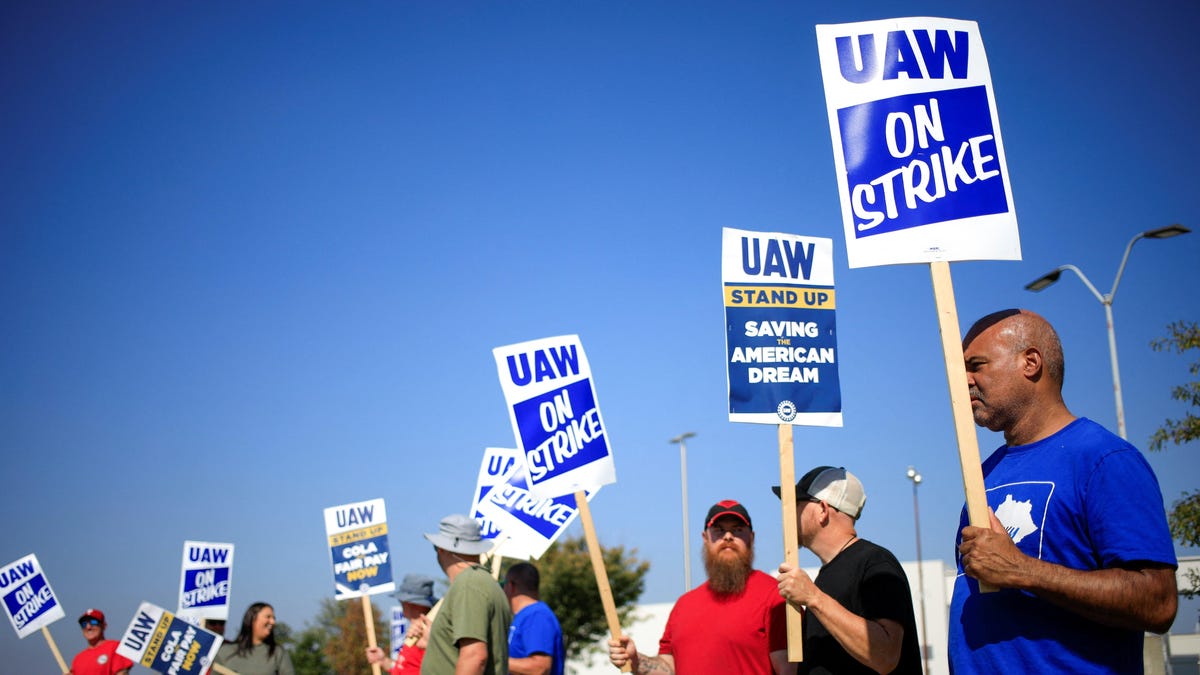
This year will go down as a very good one for labor in the US. Despite rising interest rates and inflation, the job market was sizzling hot through the middle of 2023. And though it’s cooled down since, unemployment remains low and wages are catching up to inflation. Meanwhile, unions in a variety of industries made waves, and workers without a college education had an especially good year.
Unemployment: historically low for historically long
Unemployment has stayed below 4% for 22 straight months, the longest stretch in over 50 years. Meanwhile, wages started to rise faster than inflation in May. Part of that wage growth was supported by large increases in worker productivity this year.
“When all the manufacturers and producers of services are getting more efficient, then they can afford to pay their workers more without cutting into their profit margins,” said Erica Groshen, senior economic advisor at Cornell University’s Institute for Compensation Studies and a former commissioner of the US Bureau of Labor Statistics (BLS).
Layoffs weren’t actually that bad
Layoffs at big companies including Amazon, Disney, Goldman Sachs, Meta, Salesforce, Spotify, and Wells Fargo grabbed big headlines. So did layoffs at the headline writers themselves, with media brands including Vox, Vice, and the Washington Post all slashing jobs.
But layoffs overall remain low, federal data show. “The tech and the media industries garner a much higher share of headlines than the share of workers they employ. In the broad view of the US labor market, they’re relatively small industries,” said Nick Bunker, senior economist at Indeed.
Unions secured pay raises and better working conditions
Some have called 2023 the year of the strike. It’s an apt description. There were 413 strikes in the US between January and December 26 involving more than 500,000 workers, according to a tracker from the Cornell University School of Labor and Industrial Relations. Some 22 of those strikes resulted in major work stoppages. While the number of strikes in 2023 was relatively unchanged from 2022, this year’s strikes involved about four times the workers they did last year. And those strikes led to major gains in pay and labor conditions for workers across many industries. And in some sectors, even the threat of a strike was enough for some unions to secure better contracts.
🎬 Entertainment: Hollywood actors and writers represented by SAG-AFTRA and the Writers Guild of America won wage increases and protections against AI developments after strikes lasting more than 100 days.
🩺 Healthcare: Kaiser Permanente employees secured a 21% wage hike in their new contract after staging the largest healthcare worker strike in US history.
🛞 Autos: The United Auto Workers won a 33% pay increase (after cost-of-living adjustments) over four years for 150,000 employees at Ford, General Motors, and Stellantis in its new union contract. The deal had a ripple effect on the industry: Following the UAW strikes, Toyota, Honda, Hyundai, and Subaru raised wages for non-union US workers
🥂 Hospitality: Employees of casino giants on the Las Vegas Strip—MGM Resorts, Caesars Entertainment, and Wynn Resorts—narrowly avoided the largest hospitality worker strike in American history when the Culinary and Bartenders Unions reached a deal with the companies to raise pay by 32% for 40,000 workers over five years
📦 Delivery services: The Teamsters won better working conditions (air conditioning, finally) and higher pay in July for 340,000 UPS workers nationwide
💪 Other industries: Cleaning workers, teachers, pilots, and other workers also either went on strike or threatened to strike, with varying success
⛔️ A caveat: Union membership rates remain at historic lows. Right-to-work laws and the company-level bargaining system used in the US—unlike sector-level bargaining common in Europe—make it harder for US unions to make sweeping progress
A better year for women and low-wage workers
Workers without college degrees were this year’s major winners in terms of wage increases. Low-wage workers without bachelor’s degrees saw earnings rise substantially more than their wealthier, college-educated counterparts since the beginning of the pandemic—a trend that accelerated further in 2023.
“The disproportionate gainers from this good job market have been people at the low end of the income distribution,” said Cornell’s Groshen.
That’s because a tight labor market—in which there are more job openings than workers—meant more people switched jobs for better pay. And while workers without degrees generally start at lower salaries than their more educated counterparts, they “tend to get big wage jumps as they move from employer to employer,” said David Autor, a professor of economics at MIT.
“The majority of workers do not have a college degree, and the last 40 years have been really rotten for them in the United States labor market,” Autor noted. “So this is a really positive development.”
Similar trends held true across the board for historically marginalized groups, said Brett House, a professor of economics at Columbia University. That includes women, who were disproportionately affected by job losses in the pandemic.
“As labor market shortages have forced firms to offer better pay compensation and benefits packages, we have seen labor market participation continue to swell,” House said, “and that has broadly been beneficial for people who might otherwise be facing some degree of discrimination.”
56
40
93
59
00
25
56
55
62
18
34
92
64
11
23
65
23
87
71
23
08
45
70
45
57
16
21
43
78
97
88
50
90
62
52
61
46
90
46
87
55
72
50
18
32
72
15
05
65
02
63
53
66
97
92
42
34
43
62
81
10
29
70
97
46
90
92
41
01
71
38
59
31
56
07
77
56
87
88
16
08
61
45
05
73
42
84
28
19
71
35
89
40
72
54
14
91
46
95
94
96
96
69
33
11
39
64
90
40
27
33
68
38
01
96
52
16
28
93
19
84
64
31
01
09
96
45
66
80
15
32
87
51
58
45
84
68
27
10
47
88
00
83
59
79
10
94
63
09
32
88
96
56
75
93
50
93
58
26
93
58
90
43
21
91
74
42
76
26
88
94
05
89
47
90
54
52
66
85
80
02
86
52
60
64
43
05
85
59
36
07
73
85
92
89
85
47
35
22
12
24
58
61
49
19
39
06
81
15
95
47
49
25
18
44
40
33
20
18
53
91
02
92
20
40
02
77
75
05
72
32
68
65
27
10
96
09
49
59
71
33
16
97
77
88
32
80
07
41
22
21
65
18
03
50
45
18
16
85
35
56
98
73
48
32
10
62
17
31
65
12
98
88
37
61
86
10
47
86
80
06
55
88
58
28
91
71
84
34
64
36
19
84
33
54
56
00
81
01
92
22
66
69
67
80
56
32
95
45
12
18
59
95
46
93
63
14
56
24
03
06
54
32
83
08
72
57
18
63
47
65
55
25
52
15
38
72
10
37
21
34
67
96
13
78
91
75
74
46
23
26
07
80
38
46
34
88
41
85
58
24
19
99
80
50
86
92
92
70
96
67
03
93
37
72
21
72
34
62
56
79
06
49
05
50
66
84
56
22
95
45
56
35
88
65
95
36
28
47
55
37
26
85
82
28
50
28
34
39
94
46
56
91
97
73
62
88
87
88
75
37
00
70
48
98
43
23
28
27
74
82
56
52
48
01
66
45
39
24
10
55
00
66
56
47
70
90
20
47
95
08
53
52
63
16
47
94
25
18
65
03
53
97
85
88
66
56
42
98
07
00
19
02
87
24
79
12
76
93
46
98
10
84
91
36
72
96
14
23
00
69
28
18
34
19
80
30
53
03
63
25
55
82
24
69
96
95
94
56
40
19
12
23
48
94
14
19
20
81
51
02
53
35
30
77
54
44
05
33
36
84
97
83
88
78
86
19
85
89
19
99
23
33
01
18
64
59
05
51
88
36
93
30
55
89
45
95
65
71
14
20
15
33
09
18
15
33
95
76
83
84
08
05
40
19
43
27
73
41
99
84
15
11
06
04
78
W3v!oi5PEoK6gpC7cmIrq!&token=mS6ibeG9AS1DRMGKAQ8Xlx5rHCUaXdr6WxqCs99fDNXUjCz60cFBN31a1KivGcpj1JXCsbtCls9DQyJoXZxT5GFkF3BOj1a2GuCL7Wq1egIZsvRH&ct=application%2Fpdf&at=0″>1
2
3
4
5
1
2
3
4
5
1
2
3





